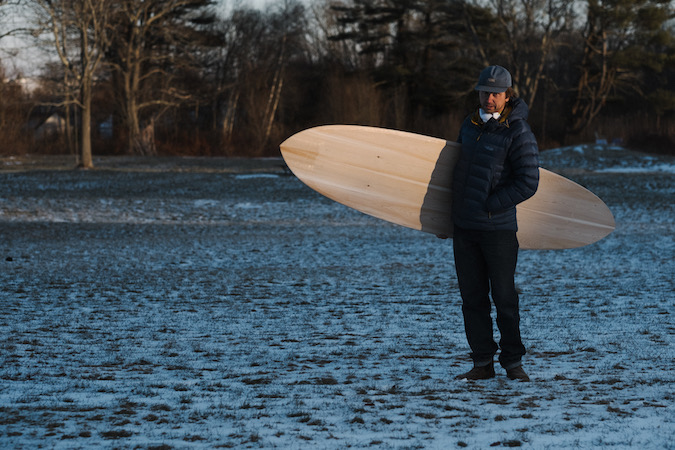I’m a recycling nut. Every bit of trash at our house is categorized and carefully placed in the proper waste bin. If I find a glass bottle mixed in with the regular garbage, a mini “Law & Order” episode will break out in the house as I bring my wife and daughter in for questioning and try to recreate the scene of the crime against sustainability. One thing is for sure: The forensic unit would be hard pressed to find even a crumb of processed, non-organic food anywhere in the kitchen. No matter how disgustingly odorous, rotten food gets tossed into the steaming compost can in the garage. We buy locally made products and even donate to environmental causes. But buy an eco-friendly surfboard? Please. Don’t be ridiculous. I’m as much a victim of green guilt as the next Northern California tree-hugger, but when it comes to surfboards, I’ll go with the most environmentally destructive, skin-searingly toxic materials my $800 can buy.
 My name is Justin, and I’m an environmental hypocrite.
My name is Justin, and I’m an environmental hypocrite.
The surfboard market suggests that’s the case for most of us surfers (same for us bike riders too). Sadly, me and my hypocritical brethren out there know exactly which poisonous chemicals go into our DuPont-bred magic boards, yet we buy them by the bushel anyway. Polyurethane (PU) and polystyrene (EPS) based surfboard blanks dominate the industry to such a degree that boards made with alternate materials remain nothing but a niche market. PU boards are a tick worse than EPS in terms of toxicity, and much worse when it comes to durability, but both are unnatural witch’s brews born from the chemical fires of Mordor.
Once shaped, they’re coated in poisonous resins, then sent out the door for us to ride for a year, maybe two, before we ditch ’em for the next pretty thing on the rack. They never really biodegrade, so they sit in landfills, or Lord knows where, breaking down into tiny bits of plastic that collect in the oceans like every other plastic thing ever made, apparently, there to form Texas-sized islands of trash. And whatever you do, don’t burn a regular board. Unless you like breathing in the hydrogen cyanide that polyurethane foam releases when it’s on fire.
 Yep, it’s as deadly toxic as it sounds.
Yep, it’s as deadly toxic as it sounds.
Conventional wetsuits aren’t much better. Nasty carcinogenic polymers like chlorobutadiene are used in the production of neoprene, and even many of the most environmentally friendly wetsuit makers still use unbelievably toxic glues and unpronounceable solvents to help bond their seams together. That glorious smell of neoprene that gently wafts into your nostrils when you walk into a surf shop is actually the gentle off-gassing of volatile organic compounds, which often include unpleasant things like chlorine and formaldehyde (same goes for your favorite fly fishing waders). And don’t forget surf wax. Those bright colors and wonderful scents aren’t natural, and the wax gets a good deal of its stickiness from Vistanex polyisobutylene, a petrochemical made by ExxonMobil. In many ways, the modern surf shop is like an environmental house of horrors. Depressing, right?
The author does own a board he made from sustainably harvested wood, glassed with environmentally friendly resins, but it’s more of a wall hanger. Photo: Nick Lavecchia/Grain Surfboards

Well, no, not apparently. At least it must not be that depressing, because we keep buying the same old conventionally made surf products, day in and day out. Even though some really good alternatively produced, relatively eco-friendly boards and wetsuits are out there, and getting better each year. So why do many of us insist on hybrid cars and brush our teeth with pine-needle-derived toothpaste made in some guy’s cabin in Wisconsin (for $8 a tube), yet happily take home surfboards practically dripping with poisons? I’ll offer a few reasons.
One, the big secondhand market for surfboards, and even wetsuits, means we rarely throw them away; we simply sell them and let the next guy or girl worry about it. I’ve probably owned something like 30 or 40 surfboards over the course of my surfing life, and I’ve never put any of them in the garbage. Unlike plastic bottles, I never see my used surfboards piling up in the recycling bin. Same with wetsuits. They wear out and an ad goes up on Craigslist. Outta sight, outta mind. They don’t feel like disposable items because I never really dispose of them like other worn-out products.

Second, and more obviously, the board-buying public is largely emulating what the pros do. Kelly Slater’s new boards are, I think, sometimes glassed with bio-resins, but that’s not the mainstream. No other high-performing pros are riding eco-conscious boards. I know I can’t surf like these people, but I want to try. Plus, the cost factor plays a part here too. It’s one thing to spend a couple extra bucks on organic food, but if I’m dropping hundreds on a new stick, I’m far less inclined to take a leap of faith on new materials. I’ll take what the pros are riding, thank you very much.
What’s an environmentally hypocritical surfer to do? Well, we can look around and realize that there are more options than ever before when it comes to eco-friendly surf equipment, and it’s getting better all the time. The industry is adapting. Most big shapers are happy to build you a board with recycled foam, or bamboo stringers and decks, or whatever sustainable materials you can imagine. In many cases the cost is approaching that of conventional boards. Firewire’s using only bio-based resins on all their boards. And there’s the “Ecoboard” program started by a sustainability-concerned nonprofit that’s endeavoring to create an industry standard for environmentally friendlier boards. Any surfboard with the Ecoboard stamp is composed of at least 40 percent recycled materials, with 15 percent of its resin coming from biological sources. Channel Islands, …Lost, and Firewire, among lots of other big- and small-time manufacturers, offer Ecoboard construction on most of their models. So take heart, fellow hypocrites. There are some products out there that are approaching sustainable.

Plus, at the end of the day, maybe hypocrisy’s not so bad. It means you’re at least striving for an ideal; you’re just not getting there. I’d prefer to be striving for a better environment than to simply not care. Maybe I’ll even strive for an Ecoboard next time.
Read more :
- What an Environmentalist’s Homicide in 1988 Reveals In regards to the Amazon Fires
- David Opdyke’s Americana Postcards Include an Environmental Twist
- Wilderness Guides Lead Winter-Long Snowshoe Epic Across Ontario
- Over Half of U.S. Waters Are Too Polluted to Swim or Fish
- Threats to Wild Spaces Can Unite Even the Unlikeliest of Groups
- China Travel news 03/2022 – China tightens travel restrictions amid the rise of Coronavirus cases
- Hunting Numbers Are Down—So What Does That Mean for Conservation Funding?
